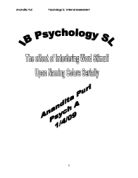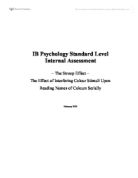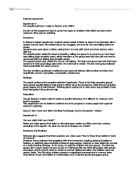Participants: All of our participants were from 10th grade and they were in the Biology class. We were on our G Period when we performed the experiment and most of the participants were between the ages of 14 and 15. We varied on the genders so we chose 9 males and 9 females for the experiment.
Materials:
- Stimuli # 1 in black font color
- Stimuli # 2 in colored fonts that matched with the names
- Stimuli # 3 in font color that didn’t match the name
- Stopwatch
- Pencil and paper for notes and data
Procedure:
- Choose wisely the place in which you will perform the experiment taking into consideration that there would be nothing distracting the participants during their experimentation.
- Collect signed consent forms.
- Take one participant at a time to the private place and clearly explain the experiment to him/her.
- Give the first stimulus for the participant to read, and take time. Write data on piece of paper.
- Perform the same steps with stimulus two and three.
- Takes notes on everything on a piece of paper.
- Process data collected on clean sheet of paper.
Results: The score recorded was verbally confirmed between the experimenters. The data was collected in one separate sheet of paper and then it was inserted into a table created on the computer. The table is neatly arranged and is easy to understand the time each contestant needed to perform the experiment.
Discussion: Our results came out to be just as we had expected. The third stimulus was the one that troubled more the participants and that was the one that took them longer to read without any mistakes. Just like the original Stroop Effect, stimulus #3 was the hardest one to complete. Our experiment was not identical to the original conducted by J R Stroop because our stimuli were different to his but they were very similar to each other. I think that the students were not prepared to do such a confusing task and that they thought it would be easier than it looks. An interesting fact we found was that we only had two black persons performing the experiment and both of them had impressive results. Both of them are Jose Treasure and Ricardo Vasquez. They did an outstanding job by reading everything really fast. Also, we found out that most of the women did badly on the experiment and maybe it was because they were shy of reading or maybe of getting stuck on a word. By doing this experiment we learned how reading something several times can really play with your mind because first the people had to read the words very easy but at the end when they did not want to read the word, they read it. So with this fact we really found out haw the mind can play jokes on you even when you want to say something, the brain directly sends a different signal to your mouth and you say a completely different thing. In conclusion, this experiment has helped me to make my first psychology experiment in my life and also it helped me to learn a lot of things about psychology and how the mind works etc. There are many differences in sex, race, color but the most important difference in all of us is our mind and how it works because it makes us a completely different person to the rest.
References:
Appendices:
Informed Consent Statement
Study Title:
Experimenter(s): (provide the full name of at least one of the people responsible for running your study)
Description of Experiment: (provide a sentence or two about the general activities participants will do)
In order to participate in this research study, it is necessary that you give your informed consent. By signing this informed consent statement you are indicating that you understand the nature of the research study and your role in that research and that you agree to participate in the research. Please consider the following points before signing:
- I understand that I am participating in psychological research;
- I understand that my identity will not be linked with my data, and that all information I provide will remain confidential;
- I understand that I will be provided with an explanation of the research in which I participated.
- I understand that certain facts about the study might be withheld from me, and the researchers might not, initially, tell me the true or full purpose of the study. However, the complete facts and true purpose of the study will be revealed to me at the completion of the study session.
- I understand that participation in research is not required, is voluntary, and that, after any individual research project has begun, I may refuse to participate further without penalty.
By signing this form I am stating that I am 16 years of age or older, and that I understand the above information and consent to participate in this study being conducted at the American School of Tegucigalpa. If I am not 16 years of age or older I must have a parent signature in order to participate.
Name (printed) _____________________________________________________________________________
Signature: _______________________________________________________ Date ________________
Parent Name (printed) _________________________________________________________________
Parent Signature ___________________________________________________Date_________________







